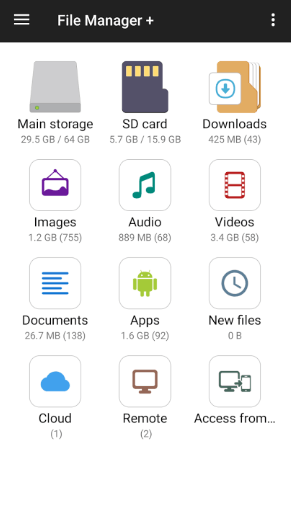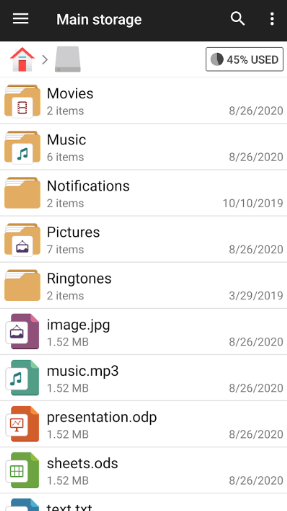In today’s fast-paced digital world, managing your files efficiently is a crucial task. Whether you’re juggling work documents, family photos, or entertainment files, a reliable file manager can make your life much easier. In this comprehensive guide, we’ll explore the world of File Manager APK, their benefits, and the features that set them apart from the stock file managers on your devices. By the time you finish reading, you’ll be well-equipped to choose the right File Manager APK that suits your needs.
About File Manager APK
File Manager APKs are third-party file management applications that offer advanced features and customization options beyond what’s typically available in the stock file managers on your Android devices. These APKs can be downloaded and installed independently, providing users with a more comprehensive and user-friendly way to navigate, organize, and manipulate their digital files.
Don’t Miss: Fake GPS Pro APK + MOD v4.1.25 (Premium Unlocked)
Key Features of a File Manager APK
1. File and Folder Navigation
File managers allow users to browse the content of their storage devices, such as hard drives, SSDs, USB drives, and cloud storage services. Users can easily navigate through their file systems, viewing and accessing files and folders with a simple click.
2. File Operations
One of the primary functions of a file manager is to perform various file operations, such as copying, moving, renaming, and deleting files and folders. These actions can be executed with just a few clicks, making it convenient to organize and maintain your digital data.

3. File Preview
File managers often provide a preview feature that allows you to see the content of files without opening them. This is particularly useful for quickly checking the contents of documents, images, and other file types.
4. Search and Filters
File managers offer powerful search capabilities that help you quickly locate files based on keywords, file type, date modified, and other criteria. Filters and sorting options make it easy to find specific files in a cluttered directory.
5. Multiple Views
Most file managers offer various viewing options, including list view, icon view, and detailed view, allowing you to choose the display that best suits your preferences and needs.
6. Customization
Many file managers allow users to customize their interface, enabling them to change the layout, colors, and other elements to make the software align with their personal preferences.
7. File Compression and Extraction
File managers often support compression and decompression of files and folders, making it convenient to create and unpack archives in formats like ZIP and RAR.
8. Integration with Cloud Storage
With the increasing use of cloud storage services, many modern file managers offer integration with popular platforms like Google Drive, Dropbox, and OneDrive, allowing users to manage both local and cloud-based files from a single interface.
9. File Synchronization
Some file managers include built-in synchronization tools that help you keep files and folders on different devices up to date, ensuring that you always have access to the latest versions of your files.
10. Access Control
Advanced file managers offer security features, allowing you to set permissions, encrypt files, and password-protect folders to safeguard your sensitive information.
11. Bulk File Operations
If you need to perform the same action on multiple files or folders simultaneously, file managers make it easy to select and manipulate them in bulk, saving you time and effort.
12. Quick Access
File managers often provide options to create shortcuts or bookmarks to frequently accessed folders, making it convenient to reach your essential files with just a click.

Popular File Manager Software
Now that you’re familiar with the key features of file managers, let’s take a look at some of the popular file manager software available for various operating systems:
1. Windows File Explorer (Windows)
Windows File Explorer is the default file manager for Microsoft Windows. It offers a straightforward interface, seamless integration with the Windows operating system, and a wide range of features, making it a versatile choice for Windows users.
2. Finder (macOS)
Finder is the native file manager for macOS, offering an intuitive and visually appealing interface. It provides features such as Quick Look for file previews, tags for organization, and seamless integration with iCloud.
3. Nautilus (Linux)
Nautilus, also known as Files, is the default file manager for many Linux distributions, including Ubuntu. It features an easy-to-use interface and supports basic file operations, as well as plugins for additional functionality.
4. Total Commander (Windows)
Total Commander is a robust file manager for Windows that comes with a dual-pane interface, making it easy to manage and transfer files between directories. It also supports a wide range of plugins for added functionality.
5. Dolphin (Linux)
Dolphin is the default file manager for the KDE desktop environment on Linux. It provides a highly customizable interface, advanced file operations, and excellent integration with KDE features.
6. Directory Opus (Windows)
Directory Opus is a feature-rich file manager for Windows that offers advanced customization, scripting, and a dual-pane interface. It’s a powerful tool for users who need extensive control over their file management tasks.
7. Files by Google (Android)
Files by Google is a file manager app for Android devices that provides a clean and simple interface. It offers file-cleaning features, offline file sharing, and a storage analyzer to help you manage your mobile storage efficiently.
8. ES File Explorer (Android)
ES File Explorer is another popular file manager for Android with a range of features, including a built-in app manager, cloud storage integration, and a recycle bin for recovering deleted files.
9. Files (iOS)
Files is the default file manager for iOS devices, offering a user-friendly interface, cloud storage integration with iCloud, and the ability to organize and manage files on your iPhone or iPad.
Download The File Manager PRO MOD APK
How To Install File Manager APK For Android & iOS
Installing the mod on your Android or iOS device is slightly different than installing the regular app. Here’s a step-by-step guide to help you get started:
For Android:
- Go to your phone’s Settings and then click on Security.
- Enable the “Unknown Sources” option to allow installations from third-party sources.
- Download the File Manager Pro APK from a reliable source.
- Once the download is complete, open the APK file.
- Click on “Install” and wait for the installation process to finish.
Once the installation is complete, open the app and log in to your account.
For iOS:
- Install a third-party app installer like TutuApp or TweakBox on your iPhone or iPad.
- Open the app installer and search for “File Manager MOD APK”.
- Select the app from the search results.
- Click on “Get” and then “Install” to start the installation process.
Once the installation is complete, open the MOD app and log in to your account.
FAQs
Q: What is a file manager?
A: A file manager is a software application that allows users to manage and organize files and folders on their computer or mobile device. It provides a user-friendly interface for tasks such as copying, moving, deleting, renaming, and organizing files.
Q: What is a file manager APK?
A: A file manager APK is an Android Application Package file that contains the installation package for a file manager app on Android devices. Users can download and install a file manager app using its APK file.
Q: How do I delete files using a file manager?
A: To delete files using a file manager, open the file manager app, navigate to the file or folder you want to delete, long-press or right-click on it, and select the delete option. Confirm the action when prompted, and the file or folder will be permanently removed.
Q: What is a file manager app?
A: A file manager app is a software application designed for managing files and folders on a computer or mobile device. It provides a graphical user interface for users to perform various file-related operations, making it easier to organize, access, and manipulate their files.
Conclusion
File managers are indispensable tools for anyone who interacts with digital files on a regular basis. Whether you’re a professional managing work-related documents or a casual user organizing personal photos and music, a file manager simplifies the process and enhances your productivity.
With features like file navigation, search, customization, and integration with cloud storage, file managers offer a holistic solution for effective file organization and management. They streamline the way you interact with your digital content, ensuring that you can find, access, and manipulate files and folders with ease.
Explore the file manager options available for your operating system, and choose the one that best suits your needs. Whether you’re a Windows user, macOS aficionado, Linux enthusiast, or mobile device owner, there’s a file manager out there to help you take control of your digital life.
In conclusion, file managers are the unsung heroes of digital organization, making your computing experience more efficient and stress-free. Embrace the power of file management software and enjoy a clutter-free, well-organized digital world.